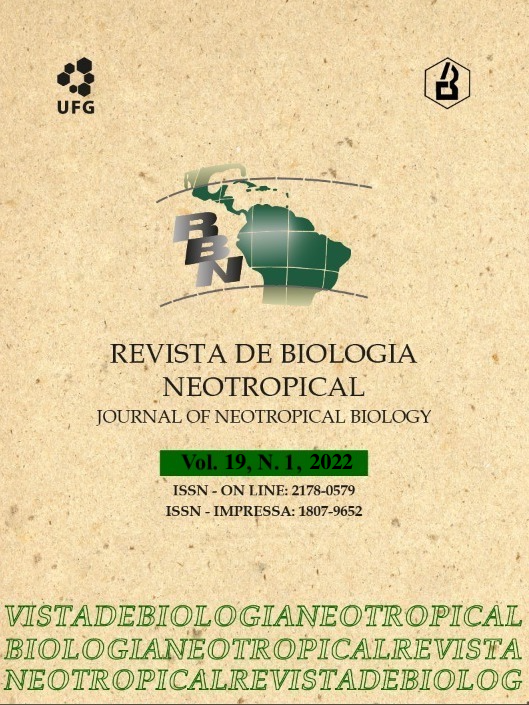First record of nests built using domestic dog hair by Todirostrum maculatum (Desmarest, 1806) (Aves: Passeriformes) in central Amazonia
Palabras clave:
breeding biology, natural history, nests descriptionResumen
The use of mammalian hair as a nest-building material by Amazonian birds is poorly documented. Here, we describe the use of the hair of a domestic dog as nest-building material by the Spotted Tody-Flycatcher, Todirostrum maculatum. The nesting pair collected the dog hair from the ground to construct their nest. The use of this material appeared to be highly opportunistic.
Descargas
Citas
Batisteli, A. F., R. Guilhermo-Ferreira & H. Sarmento. 2019. Abundance and prevalence of plastic twine in nests of Neotropical farmland birds. Wil. J. Ornith. 131:201-205. DOI: https://doi.org/10.1676/18-24
Crozariol, M. A., M. G. J. Carvalho, A. S. Paula & W. R. Telino-Júnior. 2016. Primeira descrição do ninho de Poecilotriccus plumbeiceps cinereipectus proveniente de Pernambuco, Brasil e alguns comentários sobre o período reprodutivo da espécie. Atual. Ornitol. 193: 10-13.
Di Giacomo, A. G. & B. L. Lanús. 1998. Aportes sobre la nidificacion de veinte especies de aves del noroeste argentino. El Hornero. 15: 29-38.
Ferreira, D. F., M. M. de Aquino, N. M. Heming, M. Â. Marini, F. Sá F. Leite & L. E. Lopes. 2019. Breeding in the gray-headed tody-flycatcher (Aves: Tyrannidae) with comments on geographical variation in reproductive traits within the genus Todirostrum, J. Nat. Hist. 53: 595-610. DOI: https://doi.org/10.1080/00222933.2019.1599458
Floriano, D. D., J. Lima, & E. Guilherme. 2020. Breeding biology of the Olivaceous Flatbill (Rhynchocyclus olivaceus) in an Amazonian forest fragment of northwest Brazil. Wil. J. Ornith. 132: 587-597. DOI: https://doi.org/10.1676/19-102
Freile, J. L. 2015. Nesting of the Scrub tanager (Tangara vitriolina) in Andean Ecuador. Ornit. Neotrop. 26: 51-58.
Greeney, H. F., R. A. Gelis & R. White. 2004. Notes on breeding birds from an Ecuadorian lowland forest. Bull. Brit. Ornithol. Club. 124:28-37. DOI: https://www.biodiversitylibrary.org/part/76544
Haverschmidt, F. 1955. Notes on the life history of Todirostrum maculatum in Surinam. The Auk. 72: 325-331. DOI: https://doi.org/10.2307/4081444
Hilty, S. L. & W. L. Brown. 1986. A Guide To The Birds of Colombia. New Jersey, Princeton University Press.
Ingels, J., M. Clément, M. Fernandez, G. Gazel, V. Pelletier, Rufray, V. & O. Claessens. 2016. Nesting of Smoky-fronted Tody-Flycatcher Poecilotriccus fumifrons in French Guiana. Bull. Brit. Ornithol. Club. 136: 46-52. DOI: https://www.biodiversitylibrary.org/item/252798
Jagiello, Z., Ł. Dylewski, M. Tobolka & J. I. Aguirre. 2019. Life in a polluted world: A global review of anthropogenic materials in bird nests. Environ. Pollut. 251: 717-722. DOI: 10.1016/j.envpol.2019.05.028.
Marceliano, M. L. V. 1982. Notas sobre o comportamento reprodutivo de Todirostrum maculatum (Desmarest, 1806). Bol. Mus. Para. Emílio Goeldi Nova Ser. Zool. 15: 1-21. DOI: http://repositorio.museu-goeldi.br/handle/mgoeldi/472
Melo, T. N. & H. F. Greeney. 2019. Notes on the breeding biology of birds in riverine floodplains of western Amazonia. Bull. Brit. Ornithol. Club. 139: 56-64. DOI: https://doi.org/10.25226/bboc.v139i1.2019.a4
Rodríguez-Ferraro, A & A. B. Azpiroz. 2006. Notes on the breeding biology of Maracaibo Tody-flycatcher Todirostrum viridanum. Cotinga. 25: 18-20.
Walther, B. A. 2004. Genus Todirostrum, species accounts. pp. 332-335. In: del Hoyo, J., A. Elliott & D. A. Christie (Eds.). Handbook of the birds of the world Vols 9. Barcelona, Lynx Edicions.
Descargas
Publicado
Cómo citar
Número
Sección
Licencia
Derechos de autor 2022 Revista de Biologia Neotropical / Journal of Neotropical Biology

Esta obra está bajo una licencia internacional Creative Commons Atribución-NoComercial 4.0.
La sumisión espontánea de trabajos automáticamente implica en la cesión integral de los derechos patrimoniales a la Revista de Biologia Neotropical / Journal of Neotropical Biology (RBN), después de la publicación. El autor concede a la RBN el derecho de la primera publicación de su articulo, licenciado bajo Licencia Creative Commons Attribution 4.0 (CC BY-NC 4.0).
Lo son garantizados a los autores los derechos autorales y morales de cada uno de los artículos publicados por la RBN, permitiéndoles:
1. El uso del artículo y de suyo contenido para el propósito de enseñanza y de investigación.
2. Divulgación del artículo y de suyo contenido, si lo hacer el link para el Artículo en sitio web de la RBN, permitiéndole la divulgación en:
- redes cerradas de instituciones (intranet).
- repositorios de acceso abierto.
3. Elaboración y divulgación de obras resultantes del artículo y de suyo contenido, si lo hacer la citación de la publicación original en la RBN.
4. Hacer copias impresas en pequeñas cantidades para uso personal.

















